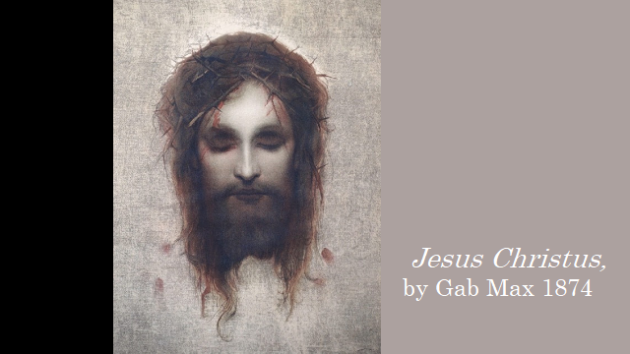The Full Picture of Christ
Casey Chalk on an 1872 image of Jesus that serves as a reminder that “Happy Jesus” isn’t always what we need in dealing with our sins.

Gab Max’s “Jesus Christus,” completed in 1874.
There is an old image of Jesus, solely of his face. His features are pale, worn, and haunting, with dark, penetrating eyes that sear into a man’s soul. Though once quite popular in Catholic homes, it is now rarely to be found. The painting is Gab Max’s “Jesus Christus,” completed in 1874. It is a shame that contemporary Christian culture has developed a bit of revulsion to such paintings, which reflects what I would argue is a tendency among Christians in our day to want only a happy, joy-filled Jesus, rather than the man who died a terribly brutal death upon the cross.
I have a deep familiarity with this particular rendition of our Lord. It was a print that hung at the bottom of the stairs, between the office and the guest room, at my Catholic grandparents home in the mountains of western Virginia. I first encountered it as an elementary schooler. As a young boy (whose parents had traded the Catholicism of their own upbringing for a vibrant, less severe evangelicalism) the painting terrified me. I had come to expect and envision a loving, tender Jesus, not one whose hollowed eyes seemed to follow me through the darkness of the house on my way to the bedroom. I would practically sprint past it, afraid to encounter such a disturbing image of Christ, and maybe even a little afraid He would come and get me!
It now, ironically enough, sits in my garage, one of many items bequeathed to me by my grandparents, something my wife and I had forgotten about while abroad in Asia the last three years. When my wife saw it, she was, like my boyhood self, a bit unnerved. She pressed me to get rid of it. Yet I think the message that visage proclaims is one all Christians need to hear and absorb into the recesses of their devotional life.
Christian – and frequently even Catholic – culture has become intensely focused on the Savior as the loving, welcoming, joyful Jesus who bid the little children come to him, who healed the sick, and loved the sinner. These are all true, important aspects of Christ and His ministry. Yet it is incomplete, and if we narrow our focus to these archetypes, our own faith will accordingly weaken.
We must remember, even apart from the Lenten season, the role of Jesus as the suffering servant of Isaiah 53 . . .
Click here to read the rest of Mr. Chalk’s column . . .


 Casey Chalk is a writer living in Thailand, an editor for the ecumenical website
Casey Chalk is a writer living in Thailand, an editor for the ecumenical website 
Leave a Reply
Want to join the discussion?Feel free to contribute!